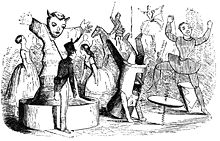The Steadfast Tin Soldier
The steadfast tin soldier ( Danish Den steadhaftige tinsoldat ) is an art fairy tale by the Danish writer Hans Christian Andersen , which was first published in 1838.
content
The little tin soldier is one of twenty-five similar tin soldiers, all of whom were cast from an old spoon and are therefore brothers. He is the only one with only one leg because he was the last figure to be cast and the tin was no longer sufficient. But this doesn't make him any less brave than the others.
He falls in love with the paper doll of a dancer who has raised one leg so high that it cannot be recognized. He thinks she only has one leg like himself and thinks the two of them would be a good match. At night he constantly watches the dancer, but is warned by a goblin not to do so, because the goblin has apparently kept an eye on her himself. The next morning he falls out of the window - “maybe it was the wind or the goblin that threw the window shut” - and is found by two street boys who let him drive in a newspaper ship in the gutter. Despite the wild ride, he remains steadfast and brave. He meets a water rat who wants to see his passport, but is able to escape it. He goes down into the canal, the boat capsizes, and he is devoured by a fish.
It's dark in there, but the tin soldier remains steadfast. Suddenly it drives “like lightning” through the fish, it gets light and a voice calls out: “The tin soldier!”. The fish was caught and sold in the market - the steadfast tin soldier has returned home. There, however, he is immediately thrown into the oven by the boy for no reason. A gust of wind blows the dancer into the stove, both of them burn, and the next day the maid finds a small pewter heart and the dancer's charred star in the stove.
criticism
Bernhard Severin Ingemann saw the fairy tale as not suitable for children. He compared the humor in this fairy tale with that of ETA Hoffmann .
The German translation by A. Graf Baudissin from 1841 expressly declares it with the subtitle “No children's fairy tale”.
Edits
- In Roy E. Disney's music film Fantasia 2000 (continuation of Walt Disney's Fantasia ), the fairy tale for the Piano Concerto No. 2 in F major op. 102 by Dmitri Dmitrijewitsch Shostakowitsch is retold or set to music; However, the ending is changed there: the tin soldier and dancer don't burn in the open fire, but the villain gets the short straw.
- British folk singer Donovan takes up the story in his song The Little Tin-Solider . Here, too, the ending is changed: dancer and soldier voluntarily jump into the fire together.
- Also Nena mentions the Rinnsteinszene in their song It's raining ; there, however, the princess travels with the tin soldier in the newspaper ship.
- Jörg Müller presents the story of the steadfast tin soldier as a picture book from an unusual frog perspective . The story is brought into the present, the princess is a Barbie doll that goes with you on the journey. The motifs of paper boats, a trip through the canal with an encounter with the rat and the fish that swallowed the travelers are taken up. But at the beginning of the journey there is a rubbish bag with old toys; the journey goes over the sea to Africa, where the fish is caught. The fish belly liberation takes place in a fish factory, and from there it goes to a huge garbage dump. The two travelers are found by a garbage collector who gives them to her son. Received joyfully by him, his father / brother gave them a car made from rubbish. A tourist buys this along with its inmates and takes it to the ethnological museum. There they stand together in the quiet glass cabinet after an exciting journey.
- In the music video of the band Heisskalt for their song Gipfelkreuz, the fairy tale is edited in stop-motion animation. In the film by Alex Schulz and Markus Arnold, however, the stove and window of the fairy tale are two treasure chests. The tin soldier and dancer voluntarily jump into the chest, which symbolizes the furnace, as they flee from the goblin.
- The figure Cyrus from the One Piece series is based on the tin soldier. He is one-legged and has been turned into a toy soldier.
literature
- Hans Christian Andersen: The steadfast tin soldier ("The steadfast tin soldier"). Bertelsmann, Munich 1997, ISBN 3-570-12421-5 .
- Hans Christian Andersen: The steadfast tin soldier and other fairy tales (audio book). Edition Jumbo, Hamburg 2005, ISBN 3-8337-1219-8 (1 CD).
- Jörg Müller: The steadfast tin soldier Sauerländer, Bertelsmann 1996, ISBN 978-3794141005 .
Web links
- The steadfast tin soldier at Zeno.org .
- Andersen: The steadfast tin soldier A book made by hand for private use
- [1] Review of Jörg Müller's picture book
Individual evidence
- ^ Eventyr, continue for Børn. Ny Samling. Første booklets. 1838. Fairy tales told for children. New collection. First issue. Reitzel, Copenhagen 1838.
- ^ Perlet, Gisela: Hans Christian Andersen, Suhrkamp Verlag, Frankfurt am Main, 2005, p. 110
- ^ Perlet, Gisela: Hans Christian Andersen, Suhrkamp Verlag, Frankfurt am Main, 2005, p. 110
